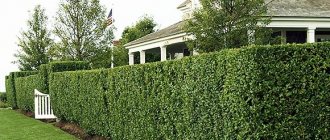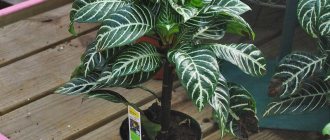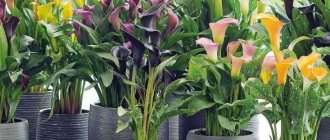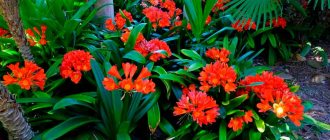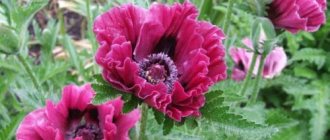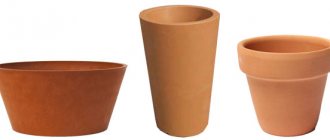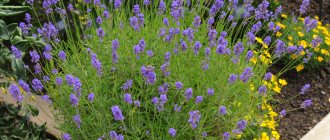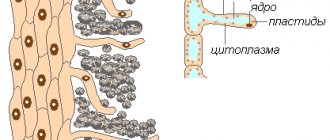Perennial
Before considering each type of climbing plant separately, you should understand the selection parameters.
To make a hedge pleasing to the eye, select young plants taking into account climate, humidity, light, soil composition - these are the most important parameters that guarantee you the most optimal selection. An important nuance is the fence itself. Thin and flimsy will not withstand heavy large vines. Self-clinging plants will not be able to climb on brick; you will have to make garters.
Advice! Do not plant several different species close to each other. You should especially be wary of ivy and hops - they will simply outlive decorative and more demanding neighbors.
Ivy
This climbing plant does not care where it grows, so it is often used in landscape design. Garden ivy survives in both hot sun and cool shade. At the same time, it grows and becomes a beautiful hedge in just a couple of months.
The plant is perennial, you will only have to tinker in the first year - the older the ivy gets, the less attention it requires. From the second year, the gardener's main task will be regular watering and pruning 2-3 times per season.
The photo shows an example of ivy growth
Hop
An excellent choice for those who do not like to care for plants, but want to decorate the garden with climbing plants for the fence. Large juicy leaves, fast growth, beautiful entwining of the fence - with hops this is guaranteed. In July-August the plant blooms profusely, and fragrant light cones are formed in place of the peduncle.
Important! Please note that getting rid of these two plants (hops, ivy) is incredibly difficult: digging or pulling them out is not enough; most likely, new shoots will appear from the ground for several more years.
Clematis
How to properly mount plants on the wall
A wire can be applied to the facade of the building, which will be stretched over the entire surface of the wall. Plants are planted down near the foundation of the building, but it is important to step back a little from the wall so that the plants do not spoil the foundation.
This fact is important because frequent watering of plants can lead to the destruction of the foundation structure. Stretching wire along the wall is the easiest option for landscaping the facade of a building.
The most difficult option is considered to be lathing. This is a special frame that will need to be welded and placed close to the wall where the greenery will be decorated. As the plants grow, they will cling to the wire or cage, creating one continuous wall of green.
You may be interested in: Paper decor: DIY fans, pompoms and flowers
Climbing plants amaze with their wonderful properties; their growth in length per day can reach fifteen centimeters. Another advantage of climbing plants is the fact that, creating a wall, they absorb a large amount of sound.
Annuals
Not all climbing plants tolerate frost successfully. If you live in a harsh climate, choose fast-growing annuals for the role of climbing plants for the fence.
Sweet pea
It will help to refine the fence and decorate decorative partitions, but it should be taken into account that it reaches only 2-3 meters in height. Grows in any conditions except wetlands. After planting, the plant requires regular standardized watering, high-quality fertilizing and special supports - otherwise it will simply crawl along the ground, occupying the area horizontally.
There are a large number of varieties of sweet peas - they differ mainly in the color and aroma of the buds.
The photo shows weaving climbing peas with shoots
Decorative beans
A light- and heat-loving climbing plant for a fence. Beans are distinguished by their decorative juicy greenery, which is why gardeners love them. It does not require special care, but for more lush growth and abundant landscaping, nitrogen fertilizers can be used.
Also take into account her love for watering: the hotter it is outside, the more often the hedge is watered, up to a daily repetition.
Advice! The fruits of decorative beans can be collected and even eaten - to make more of them, the shoots are regularly pinched.
morning glory
Climbing plants to decorate the walls of houses
One of the most popular wall decoration options is planting climbing plants. They will grow with great speed and cover the wall with greenery, giving it a beautiful and well-groomed look. Landscaping can be done not only to make the facade of the house beautiful, but also to cover up old, unkempt buildings.
Many facades of the walls of houses and barns require maintenance and repair. In order to avoid repairing the walls, you can simply plant climbing plants around the perimeter.
One of the most famous climbing plants is the liana. This is Chinese lemongrass . It will quickly braid the desired part of the wall and hide all surface roughness. The advantage of vines is that they produce delicious berries that can be picked later. They give a person tone.
You may be interested in: How to make a topiary with your own hands, how to decorate it and where to put it
You can also plant Amur grapes . It also produces berries that have a slightly sour taste. But this plant will very beautifully and densely cover the facade of the building.
With the help of climbing plants, you can not only create a beautiful design for the facade of the walls, but also make arches in the garden, you can even come up with and build hanging gardens.
Winter-hardy
The evergreen climbing perennials from the first section survive even harsh winters without loss, but there are other options.
Honeysuckle
Ornamental species, such as honeysuckle, climb beautifully and bloom profusely throughout the season. But they have a drawback: the berries of these varieties (unlike shrubs) cannot be eaten, they are poisonous - so you should not plant them in an area where children can reach the fruits. Mature plants tolerate frosts without problems; they are not even removed from their supports. Young ones (up to 2-3 years) are best removed and covered at the end of the season.
Honeysuckle loves moist soil, so it is better to mulch the surface after planting to retain moisture. It grows best in the sun; the darker it is, the slower it will develop and bloom less.
Woodplier
As the name implies, this vine has more than enough strength and desire to live: without control, it will quickly kill other plants from the area and take over the territory. But with timely pruning, a hedge, even based on a picket fence or chain-link mesh, looks very decorative.
The tree plier survives the winter without much loss; you should not worry even if some of the shoots freeze. Thanks to its powerful root system, it will quickly recover with the arrival of warmer weather.
In the photo there is a wood plier entwined around an arch
Chinese lemongrass
This type of hedge has nothing to do with citrus fruits; the name was given solely because of the pleasant aroma of the fruit. Schisandra takes root and winters even in Siberian and Far Eastern territories, not to mention the mild winters of the central part of Russia. The only thing to keep in mind is that it does not like the sun, but it is ideal for decorating the shaded side of the fence.
Important! Schisandra stems are dried and brewed as tea - this drink has a restorative, energetic effect. Increases blood pressure, can even replace coffee.
Plants with flowers
climbing rose
Suitable for experienced gardeners and those who are ready to care for this complex plant. Thorny shoots with flowers require careful handling and timely garter. But if everything is done correctly, during the flowering period the site will turn into a real imperial garden. It can overwinter, but in the fall it is wrapped and covered. Although even such a scenario does not guarantee a successful winter for the climbing rose.
The photo shows a profusely blooming rose
Important! Climbing roses are more susceptible to attack by aphids and spider mites than others. Carefully monitor the health of the seedling; timely measures taken when pests are detected will save the life of the plant.
Kobeya
In fact, the plant itself is a perennial and in the southern regions it blooms successfully for several years after planting. But it cannot be classified as winter-hardy, so in most of Russia it is grown as an annual - it grows quickly, blooms in the first year, and is suitable for decoration.
The leaves are quite large and beautiful, but kobeya is loved not for them, but for its charming bell-shaped flowers. There is no need for tying; the vine releases tendrils and grabs the support with them, climbing up on its own. Loves sunlight, can grow in partial shade, but not in dark areas.
The photo shows an example of a kobei garter
Nasturtium
Let the sun into your summer cottage: plant the original nasturtium! Near the fence you will need additional lashes and garters along which the plant can climb up. To ensure juicy and long-lasting flowering, plant in a bright place - both open ground and tubs or boxes are suitable. The flowers are large, bright - orange, yellow, red. White or pastel shades are less common.
Wisteria
A beautiful design option for fences, arches, and gazebos. Large clusters of flowers in a fresh purple hue combined with green foliage give a charming look to even the simplest buildings. Wild varieties prefer the hot climate of the subtropics, but breeders have developed species that can survive cold temperatures down to -37C. Are you planning to grow wisteria on your property? Look for the varieties that are most suitable for your climate.
Tips for growing climbing perennials
Perennial vines are widely used by gardeners for landscaping. Their diversity, which currently exists, helps solve many issues regarding the improvement of a garden plot:
- give the feeling of a cozy oasis;
- cover unsightly buildings, camouflage old trees;
- divide the garden into zones (for example, rest and work);
- create a picturesque alley;
- make a living screen to protect from dust, sun, noise, and prying eyes;
- decorate arches, gazebos, balconies and other elements of the garden with abundant flowering vines.
Perennial loaches have their advantages over annuals. They are cold-resistant, do not require annual planting, survive winter well in open ground and do not require special care.
Climbing perennial flowers are more suitable for those summer residents who rarely visit their country house. Perennial vines are easy to care for and are almost the first to show their greenery in the spring, weaving around a fence or climbing a wall. There are many types of loaches, among which you can choose for practical and aesthetic reasons.
Actinidia
Actinidia was cultivated not so long ago, but it already has 75 species of loaches, many of which can be easily grown in mid-Russian latitudes. In nature, actinidia grows in Southeast Asia, the Himalayas, and the Far East.
The perennial loach demonstrates its decorative properties throughout the growing season, changing the color of the leaves from soft green with a bronze tint to dark with a white tint and, finally, becoming a pink or raspberry bush.
READ MORE: How to make a screen for a room with your own hands
Ampelopsis
Ampelopsis belongs to the Grape family, but it is famous for its unusual and very attractive appearance. Perennial loach in climates with cold winters reaches 3 m in height. Its leaves resemble grape leaves, but each type has its own color. The stems are reddish-purple in color. The loach clings to the support with its long antennae.
Azarina
Azarina climbing is a perennial loach, from the root system of which several new shoots grow annually. But this happens only in a warm climate zone at a constant temperature of at least 200C. On the territory of Russia, loach can be grown either as an annual or as a perennial, but in indoor conditions.
This loach has highly branching shoots and is capable of growing quickly in any direction. With its help you can landscape a loggia, terrace, gazebo, or create a decorative emerald wall of dark green velvet leaves with large bell flowers of different colors.
Wisteria
In nature, wisteria grows freely in the humid subtropical forests of Japan, China, and Korea. This loach with drooping branches-lianas can reach a height of 15-18 m. The perennial is widely used in many countries in landscape design, decorating gardens and parks with an unusually bewitching appearance of purple, white, blue, pink flowers collected in large inflorescences-tassels. It’s not for nothing that the Japanese call a walk surrounded by wisteria flowers a “walk through the Garden of Eden.”
Attention! The flowering of Chinese wisteria can be enjoyed only 3 years after planting the loach, and Japanese - only in the 10th year of the perennial’s life.
Hydrangea
Hydrangea can be seen as a small tree, shrub or loach climbing a support 30 m. Hydrangea flowers are small, they are collected in huge spherical inflorescences and come in different colors: white, pink, purple, blue. In Japan, this loach is called "ajisai", which translates as "purple sun flower". A very winter-hardy perennial loach that can withstand harsh winters.
An enterprising gardener with skill can use the fast-growing ability of perennial vines like hops (shoots can grow up to 20 cm per day) to create vertical green walls with large, bright green foliage and attractive buds.
In mid-latitudes, common hops are grown - a climbing perennial, the upper part of which completely dies off by winter. This allows the gardener to clear the area and prepare supports for next year.
Clematis
Clematis has about 300 species and grows on all continents under different climatic and natural conditions. Most of them are climbing vines with long flexible shoots. In northern and middle latitudes, clematis shoots die off during the winter, and the next year they grow from dormant buds on the underground part of the vine.
Clematis flowers can be small or large, single or collected in inflorescences. Colors can vary from white to dark blue and purple. The flowering of the perennial loach begins in spring and lasts until the first frost.
Princes
Knyazhik is a perennial shrubby loach with a woody stem. It climbs up to 2 m in height, clinging to supports with twisted leaf petioles. Very similar to clematis. Both loaches belong to the same genus, but differ in flowers. Prince has 8 types, differing in colors. Half of them are frost-resistant. This quality makes it possible to successfully grow perennial loaches throughout Russia.
Fallopia
Fallopia can be either annual or perennial. The loach has a stem up to 5 m long. Its ability to quickly fill empty spaces can be successfully used to cover up unsightly spaces. Refers to climbing perennials that bloom all summer. The flowers are small, collected in inflorescences. Some types of loaches are good honey plants.
climbing rose
Climbing roses are considered leaders in vertical gardening. Their lush flowering, rising along the installed support, captivates all flower lovers. Loaches are divided into 2 main groups:
- Ramblers - have arched or creeping shoots up to 5 m long.
- Climbers - a climbing vine obtained by crossing several varieties.
A climbing rose can decorate any structure: both large and small, entwining a gazebo, arch, column, fence. The beautiful combination of climbing perennials with other plants allows you to create extraordinary compositions.
Kampsis
The beautiful, fast-growing Campsis loach is native to North America and China. In Europe, they have been decorating gardens and parks since the 17th century. The spreading stems are covered with large, bright, tubular flowers up to 8 cm in diameter. The petals, fused at the base into a corolla, are colored orange, pink, or crimson. The perennial grows successfully in central and southern Russia.
Honeysuckle
Honeysuckle is a climbing perennial, a deciduous shrub that grows up to 6 m in height. It is grown for decorative purposes for vertical gardening. The plant is unpretentious, grows quickly up to 120-170 cm per year. Blooms profusely from spring to autumn with bright red-orange or light purple flowers with a pleasant, persistent aroma. In autumn, the loach is covered with beautiful bright red inedible fruits.
Ivy is a perennial loach. They are widely used in vertical and hanging gardening thanks to the adventitious roots with which ivy firmly clings to everything it encounters on its way. Loach is famous for its unpretentiousness and rapid growth. Large leaves of different shapes, which can be green, variegated, yellowish, with a white border and red splashes, give the loach its decorative appearance.
Woodplier
Wood pliers is a lignified perennial loach that naturally lives on both American continents, Central Asia, Africa and Australia. The tree pliers got their name from their parasitic lifestyle. Thanks to its rapid growth, the loach wraps around a nearby growing tree and grows inside the trunk, drinking the juices of the donor. Due to its abundant green mass and orange fruits, wood pliers have found their use in landscape design for landscaping fences, gazebos, and building walls.
Attention! Wood pliers should not be planted near trees to avoid their death.
Clematis
Clematis belong to the buttercup family and are climbing and creeping perennials. They grow in temperate climates along river banks, on cliffs and rocks, in the steppe zone. They have leaves of different shapes and flowers, small or large, of different colors. They are very whimsical and require a lot of light, heat, water and fertile soil. Loaches have found wide application for covering walls, trellises, decorating balconies, and borders.
READ MORE: Lamps for stairs 74 photos options for illuminating steps in a private house LED lighting with motion sensors
Kirkazon
Kirkazon has many other names:
- aristolochia;
- fever grass;
- woman in labor;
- kokornik
This perennial loach belongs to the very ancient genus Karkizon, which existed even before the division of the land. It has a creeping rhizome, weakly branched shoots that grow up to 8-14 m in length. It also has decorative large leaves that create a dense and spectacular foliage cover.
Conditions for growing climbing and creeping perennials vary and depend on where the plant comes from. Therefore, you need to approach the selection of a perennial and the creation of growing conditions with an understanding of what the loach needs.
However, some growing conditions are the same for all loaches:
- the correct selection of location (sun or shade) will ensure rapid growth of the perennial;
- Loaches should not be planted close to a fence or wall; the distance should be at least half a meter so that the root system is freely located in the soil;
- supports must be placed before planting the perennial, calculating the weight that will fall on the support from the loach;
- In order for a perennial to have a decorative appearance, you need to direct its growth from the first day, create volume and trim off fading branches.
The right combination of different varieties of climbing perennials, blooming at different times, will create a unique look for your garden plot.
Most gardeners choose perennials to decorate their fences, as this allows them to avoid planting new plants every year. Their feature is powerful stems, which create a significant load on the fence, so the support must be strong enough. Often perennial climbing plants delight not only with their magnificent appearance, but also with edible berries. Among such varieties for fences are honeysuckle, actinidia and nightshade.
Before buying a plant, you should think carefully about what you want to see on the fence in the end, since perennials can be flowering and have only decorative foliage with barely noticeable inflorescences.
